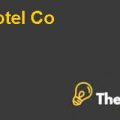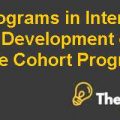Lou Gerstner At Ibm Case Study Solution
Evaluation of Organizational Culture
IBM had a strong organizational culture in mid 1930s. Its employees were praised for their high loyalty and motivation. In 1993, when Gerstner took over IBM, almost all employees shared strong values related to respect for each other, hard work and a moral behavior. However, the culture was based upon certain hard and fast rules like; a dress code of dark suits and white shirts, no drinking at organizational gatherings etc. These values were derived from the founder of the company.
However, Gerstner believed that the values had transformed into hard and fats rules which even did not portray the actual vies of Watson. For example, the dress code was set specially for the salespeople on the basis of the dress code of consumers at that time, which implies that Watson’s views behind a strict dress code was to wear according to the place and people. However, the consumers are changed now, their dressing styles are also being changed, but the traditional dress code at IBM had not been changed for many years.
Along with it, various business units of IBM was focused on increasing their internal efficiency and profitability rather than improving performance of the overall organization. The units used to compete with each other with hiding data from each other, debating over pricing terms etc. moreover, and the compensation system was based on individual performance rather than a collective performance approach.
The organizational culture with competing business units and the high follow up of the hard and fast rules along with the negative attitude about change do not align with the new strategy which is to be pursued to improve the overall organizational performance. Therefore, in order to implement its new strategy, Gerstner should align its organizational culture with the strategy.
Task Capabilities
Although, the new strategy would enable the company to gain its reputation back and would allow the company to improve its overall performance, but the current organizational structure, organizational structure, employees behavior and the task systems including the compensation systems would resist the company to implement its new strategy. Therefore, the company should consider the achievement of these task capabilities in order to implement its strategy. It should centralize its organizational structure in order to manage its local and foreign business operations under a single unit to provide high value to its global customers. Along with it, the company need to change its organizational culture from product centric to consumer centric. Moreover, the compensation system should be modified from compensation based upon individual performance to collective performance.
The other task capabilities which the company need to implement its strategy include the strong database related to the consumers in the different countries. Along with it, the company need an integration between its various business units to manage the data transfer. Along with it, it needed a system measuring the overall performance based upon various performance measures.
However the company does not possess a better database for the information regarding its consumers and market. Along with it, it does not have a strong integration system between its various business units. There is also no proper system of measuring the overall performance on the basis of the value provided to customers.
In order to acquire these task capabilities, the company should first try to improve its overall financial performance in order to fund the implementation of its new strategy. After that it should change its organizational structure and convert it into a centralized less complex structure. It should try to modify its organizational culture by changing employee attitudes through the use of punishment and rewards. It should build a database for its local and global customers in order to gain an overview about the market conditions and the consumer preferences. The acquisition of these task capabilities would enable the company to align its internal business operations with the external business environment to pursue its new strategy.
Evaluation and Compensation Systems
The existing compensation systems are based upon individual performance rather than collective performance. The evaluation for the performance is made on the individual basis rather than on company basis. In order the pursue its new strategy, the company require the coordination between all of its business units in order to provide high value to customers, however, the compensation and evaluation systems based upon individual performance does not support the provision for high value to customers. The business units competing with each other do not create a sense of providing high value to customers collectively. Therefore, in order to implement its new strategy, the company should align its compensation and evaluation systems with its overall internal operations.
Evaluation of Budgeting and Resource Allocation Systems
As all the business units are almost independent with each business unit competing with each other over pricing terms, the budget and resource allocation system seems to be based on the individual performance. The independent budget and resource allocation systems does not support the new strategy of the company of providing high customer values using services with a mutual consideration. The budget and resource allocation should be aligned with the internal operations and strategic vision of the company in order to implement the new strategy.
Employee Resistance
The strategic shift prom product orientation to customer orientation was not quite easy an would bring resistance from the existing employees. The current IBM culture with major focus on manufacturing could not accept the service business easily. Major resistance would come from the side of the sales people of IBM. As the service business requires recommendation of competitor’s products if it best suit the customer to provide high value to customer, the current sales people, who always consider IBM products to be the best, cannot digest this point.Along with it, the whole sales force would resist the entrance of the new service person in their team who would recommend competitive products.
Evaluation of Misalignments
By analyzing the given pyramid and the parameters at IBM, it could be determined that there are various misalignments at IBM, which could be aligned in order to implement the new strategy. The people at IBM are resistance with the change and the strategic vision requires the employees to get changed. Along with it, the decentralized organizational structure does not comply with the new strategy of providing high value to customers with collective efforts. Moreover, the work systems like budget and resource allocation does not comply with the proposed new strategy.
Alignment by Lou Gerstner
Lou Gerstner assumed that in order to pursue his new strategic vision, the internal operations must be in alignment with each other and with the external environment and the strategic vision in order to gain the optimal performance. Therefore, he focused on changing the organizational culture, the organizational structure and the employee’s attitude to implement his strategy.
Conclusion
The introduction of Lou Gerstner could prove a strategic shift in the operations at IBM. The new CEO has brought his new strategic vision. With the changing industry patterns and customer preferences, the IBM must consider a strategic shift in its business in order to sustain a long term competitive position in the market. Although, the strategy proposed by Gerstner, which is focused on shifting the company’s core values from being product centric to consumer centric, would result in increasing margins and revenues at IBM, but the organizational culture and the organizational structure must be first aligned with the strategic vision in order to implement the new strategy.
Appendices
Appendix-1
This is just a sample partical work. Please place the order on the website to get your own originally done case solution














